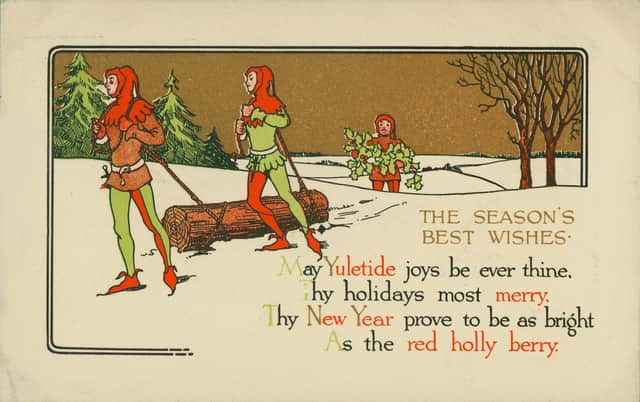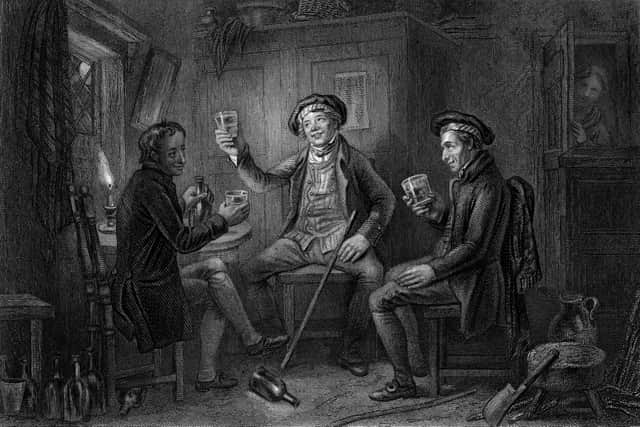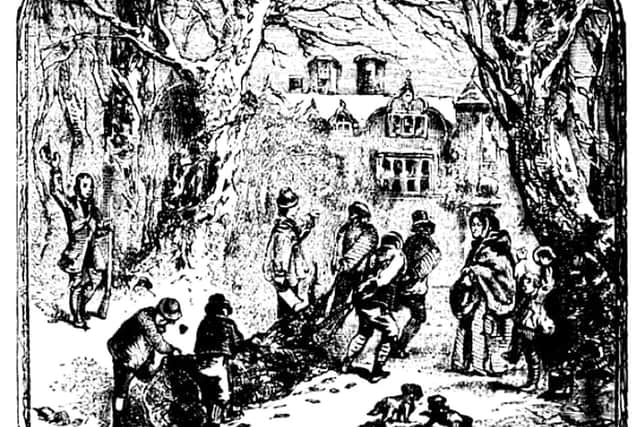Hogmanay: The lost traditions of Scotland's festive 'daft days' of old


With the old feast of Christmas generally discouraged by the Kirk following the Reformation, special focus was placed on the turning of the New Year with the period running up to Hogmanay – and its aftermath – always fulsomely celebrated in Scotland.
This 12 days between Christmas and Twelfth night were given over to celebration, merriment and excess, with the period hailed as the “daft days” by 17th-century Scots poet Robert Fergusson.
Advertisement
Hide AdAdvertisement
Hide AdAlso later referred to as the “easy-going olden times”, no work was done during the festive spell, when time was instead spent on “friendly festivities and expressions of goodwill”.


During this spell, which was known as Nollaig in the Highlands and Western Isles, a common saying was often shared: “The man whom Christmas does not make cheerful/Easter will leave sad and tearful.”
Rituals surroundings the 12-day celebration, also known as Yule, can be traced back to our Celtic ancestors, who believed the sun stood still for 12 days during winter. Mitsleltoe was cut by druids in the low winter sun and blessed in a celebration of life, with the Yule log lit to bring light into the dark.
In Gaelic speaking areas, Hogmanay was referred to as either ‘Night of the Candle’ or ‘Night of Blows’ given one ritual which involved a man having a dry cow hide placed over his head before being beaten like a drum as he and his friends moved around their home village.


Usually led by a piper, the group would move around each house, turning anti-clockwise, striking the walls and reciting rhymes to raise the householders. As doors opened, the group would pile into each home to receive refreshments such as oatmeal bread, cheese, flesh and a dram of whisky, according to John Gregorson Campbell in his encyclopedia of customs, The Gaelic Otherworld.
The idea was to “drown the animosities of the past year in hilarity and merriment,” Campbell wrote.
Holly also played a role in the party. It was hung in the belief it would keep the fairies away but boys were also whipped with a branch of the greenery.
Every drop of blood spilled counted the years the boy would live and although it sounds fairly grim, it was reportedly a ritual practised in good jest among friends.
Advertisement
Hide AdAdvertisement
Hide AdHogmanay night was sometimes referred to as New Year’s Night with the fire in the home playing a central part in the superstitions during the countdown to midnight,
It was feared that letting the fire go out would invite bad luck into the home with only householders - or a friend - allowed to tend it. Candles were usually lit as back up to ensure a flame remained in the house on December 31, leading to the name Night of the Candle as a result.
New Year’s Day, like the first of every quarter of the year, was a great ‘saining’ day across the Highlands and Islands when rituals were at their most intense to protect cattle and houses from evil.
Juniper was burnt in the byre, animals were marked with tar, the houses were decked with mountain ash and the door-posts and walls and even the cattle were sprinkled with wine.
The morning of January 1 started with a dram poured by the head of the household with a spoon of half-boiled sowens, or oatmeal husks, considered the poorest of all the foods, given for luck.
Many Scots considered Handsel Monday – the first Monday after New Year – as the great winter holiday of the year.
For 500 years, it was regarded as a day of family and merriment with small gifts exchanged between neighbours and friends.
The word “handsel” originates from the old Saxon word which means “to deliver into the hand”.
Advertisement
Hide AdAdvertisement
Hide AdWith the holiday a great celebration among rural and farming folk, particularly in the Lowlands, it was usual for workers to be treated in some small way by their masters.
On Handsel Monday, half a crown or a shilling would often be collected from the big house, with a piece of cake and glass of toddy also shared while the bosses tended to the graft of the day.
Fife and Perthshire were two areas of Scotland where Handsel Monday was celebrated long into the 19th Century, despite New Year’s Day becoming the holiday of choice in cities such as Dundee and Glasgow
A report in the Dunfermline Press in 1890 said: “On farms, Auld Hansel-Monday, where it is kept, is the great winter holiday of the year.
“Outdoor and indoor servants have a complete escape from bondage for the day, and many a farmer will own that the hardest day’s work for him and his wife throughout the year occurs on Handsel Monday.
“The necessary labours of the farm have to be done on that day by the members of his household."
There were no lie ins, however, despite the day off. It was usual for workers to get up extra early so they had as much time as possible to enjoy the holiday.
Villagers were usually woken up by young residents kicking tin pans through the streets to mark the beginning of the day. Breakfast was fat brose, made from beef fat poured on oatmeal, with bonfires lit after the first meal of the day.
Advertisement
Hide AdAdvertisement
Hide AdOn January 6, 1870, the Perthshire Advertiser noted the celebrations of Handsel Monday - described as the “holiday-in-chief” of the year - in Auchterarder .
It was marked with “much noise and boisterous mirths,” the newspaper said.
“Boys, carrying flambeans, began to perambulate the town shortly after 12 o’clock and from that hour till morning the streets resounded with their hideous noise.”
Pubs drew large crowds and people were “well fortified within” as the workers shrugged off their daily life and indeed went rightly daft.
A message from the Editor:Thank you for reading this article. We're more reliant on your support than ever as the shift in consumer habits brought about by coronavirus impacts our advertisers.
If you haven't already, please consider supporting our trusted, fact-checked journalism by taking out a digital subscription.
Comments
Want to join the conversation? Please or to comment on this article.
